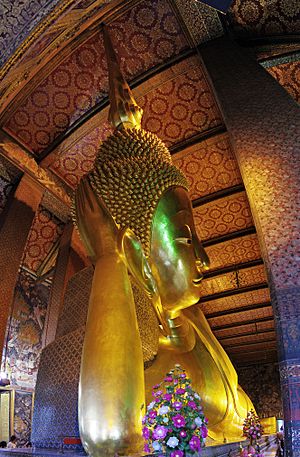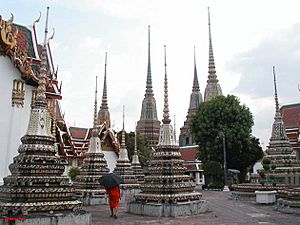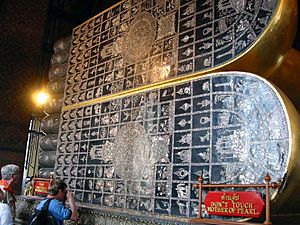Wat Pho facts for kids
Wat Pho is a very important and famous Buddhist temple in Thailand. People often call it the "Temple of the Reclining Buddha" because of the giant Buddha statue inside. It is one of the biggest and oldest temples in Bangkok, Thailand's capital city. Wat Pho is also known as the place where traditional Thai massage first started. It has more pagodas (tall, tower-like structures) than any other temple in Thailand, with 99 of them!
A Look at Wat Pho's History
Wat Pho was built on the site of an even older temple called Wat Photaram. In 1788, King Rama I rebuilt the temple. It took a long time to finish, about seven years, five months, and 18 days! King Rama I also changed its name to "Phracheatupon Vimonmungkrawat." Later, King Rama III (who ruled from 1824 to 1851) made many repairs and improvements to the temple. Even later, King Rama IV gave the temple its current full name, "Wat Phracheatupon Vimonmungkraram." Today, Wat Phracheatupon Vimonmungkraram is a very popular place for tourists to visit.
The Amazing Reclining Buddha
One of the most incredible sights at Wat Pho is the "Reclining Buddha," also known as Phra Buddhasaiyas. This huge statue is about 46 meters (151 feet) long and 15 meters (49 feet) high! It was created when King Rama III was doing his repair work on the temple. The Buddha's body is covered in shiny gold. Its eyes and feet are decorated with beautiful mother-of-pearl. The bottom of the Buddha's feet are especially unique. They show 108 different scenes made from shells, combining both Chinese and Indian art styles.
Images for kids
See also
 In Spanish: Wat Pho para niños
In Spanish: Wat Pho para niños
















